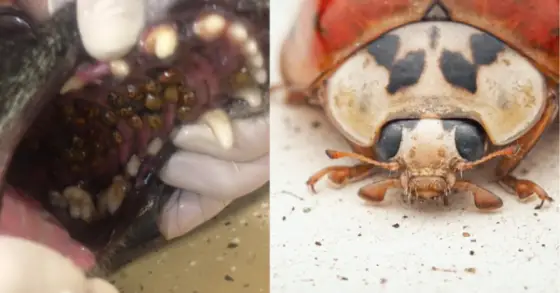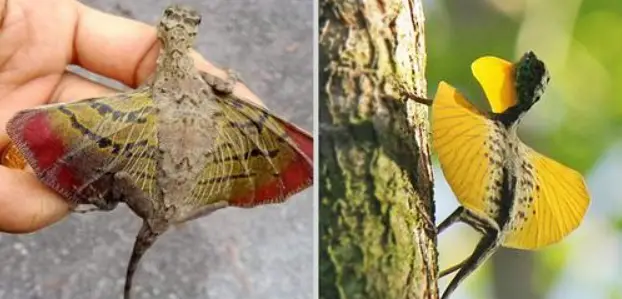As the cold weather descends each year, dog owners must be on high alert for seasonal pests that can cause extreme discomfort for their pups. This tiny but mighty creature is adept at stealthily latching onto dogs’ mouths when temperatures drop, irritating the sensitive skin and making eating a painful chore.
The havoc this culprit wreaks is very real. Infestations often strike without warning, leading to intense itching, redness, and even open sores in dogs’ mouths. Left untreated, these mystery pests can endanger your dog’s health.
Luckily, with proper vigilance, dog owners can spot the signs of an infestation early and take steps to banish these annual pests before they take hold. In this article, you’ll learn how to thoroughly inspect your dog’s mouth, why these pests thrive in the winter, and how to provide relief if your pup is affected.
Protecting Your Dog Against These Seasonal Pests – The “Asian Lady Beetle”
It’s been a while since the gruesome photo of a dog’s bug-infested mouth circulated the internet, but we can’t forget about it just yet. As it gets colder, these painful pests are looking for warm, humid places to call home, including your dog’s mouth.
If your dog likes to sniff around the garden, they might encounter a lady beetle or two. These bugs react negatively when disturbed and are the only bugs of their type that will bite if threatened.
If they manage to latch onto the top of your dog’s mouth, they will dig in and stay there. While some dogs might be able to wash them away by drinking water, others might not be able to shake these pests.
Signs Of A Lady Beetle Infestation

Here are some signs that Asian lady beetles may have infested your home:
- Large numbers of lady beetles clustering on the exterior of the home on sunny walls. They may congregate in cracks and crevices.
- Beetles spotted crawling on windows and trying to get inside. They are attracted to warmth and light.
- Finding numerous dead lady beetles in window sills and window wells. This indicates they are trying to enter.
- Presence of larvae – Look for congregation of yellow-orange larvae with black spots in wall voids and attics.
- A foul, bitter smell coming from places where lady beetles are clustered. They secrete this for defense.
- Unexplained stains or odors on walls, ceilings, or floors. Dead lady beetles can leave behind stains.
- Dogs exhibiting mouth discomfort symptoms after being inside areas where lady beetles are present.
Taking steps to seal up entry points, vacuum up larvae, and clear clusters outside can help prevent infestations that put your dog at risk. Let me know if you need any pest control recommendations to keep these beetles at bay.
Here are some signs that your dog may have an infestation of Asian lady beetles in its mouth during the winter months:
- Excessive drooling or foaming at the mouth – Asian lady beetles secrete a foul-tasting liquid that causes dog’s to drool and foam more than usual.
- Pawing at the mouth – The irritation from the beetles clinging to the roof of the mouth causes dogs to constantly paw at their mouths.
- Loss of appetite or difficulty eating – The presence of the beetles can make chewing and swallowing painful. Affected dogs may turn up their noses at food.
- Reddened gums or roof of the mouth – The beetles’ tiny legs grasp the soft tissues of the mouth, causing inflammation and redness where they attach.
- Coughing or gagging – Some dogs will cough or retch as they try to dislodge the beetles.
- Bad breath – The secretions from the beetles and wounds they inflict contribute to an unusually foul doggy breath.
- Multiple beetles visible in the mouth – Parting your dog’s lips to inspect inside may reveal numerous tiny black beetles clinging to the roof of the mouth and gums.
Keeping an eye out for these signs can help catch an Asian lady beetle infestation early and get your dog prompt relief. Let me know if you need any other details!
The Difference Between Lady Bugs & Lady Beetles
While they may look nearly identical to the untrained eye, Asian lady beetles are in fact an invasive species entirely separate from the beneficial ladybug insects many know and love.
Native to Asia, Asian lady beetles were introduced to North America in the last century as a form of agricultural pest control. But these beetles quickly spread out of control, establishing wild populations across the continent.
Unlike familiar red and round native ladybugs, Asian lady beetles can range in color from red to orange to yellow, and have a distinguishing small white “M” shaped marking on their foreheads. They are an unwelcome pest known as the “evil twin” of the beneficial ladybug.
In winter, Asian lady beetles seek shelter in homes, swarming around windows and walls on warm days trying to get inside. Once indoors, they release a foul odor and staining secretions, damaging walls and fabrics.
It’s crucial to safeguard your home by sealing any cracks and crevices so Asian lady beetles can’t get indoors. Any infestation should be vacuum cleaned up immediately. Allowing them to establish themselves puts your home and pets at risk.
In Conclusion:
While at first glance Asian lady beetles may resemble our beloved, benevolent ladybugs, they are in fact an entirely different species. Introduced from Asia as a misguided form of pest control, these beetles have now become major pests themselves across North America.
Unlike ladybugs, Asian lady beetles seek shelter in homes during winter, leaving behind foul odors, stains, and general nuisance. Their habit of aggregating in mouths of outdoor pets like dogs brings pain and general misery.
Homeowners must be vigilant in sealing up any exterior openings that could allow these invasive pests entry. Checking pets’ mouths for symptoms and immediately removing any beetles found is key to relief. With awareness and proper prevention, Asian lady beetles can be managed.
In a world already struggling with invasive species crises, the Asian lady beetle stands as another reminder that introducing new species, no matter how similar to native ones, can have disastrous consequences we cannot foresee. We would do well to appreciate our scarlet ladybugs, and keep their tawny-colored imposters at bay.





